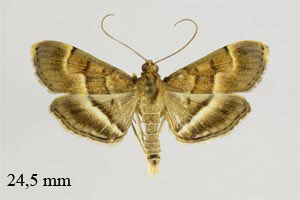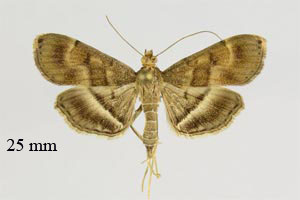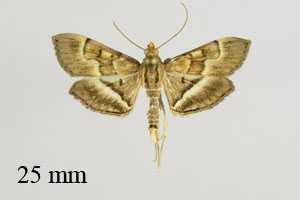

 +1Kontinente:NA
+1Kontinente:NA2. Diagnose
2.1. Männchen
2.2. Weibchen
3. Biologie
3.1. Nahrung der Raupe
- [Fabaceae:] Erythrina sandwicensis Hampson, 1898 [Originalkombination]
Haines et al. (2004: 49) notierten: "Zimmerman (1958) reported its principal native host to be wiliwili, Erythrina sandwicensis Degener, but he also listed several other native and non-native legumes as alternate hosts for the caterpillars."
4. Weitere Informationen
4.1. Faunistik
Meyrick (1888: 216) beschrieb die Art ohne nähere Fundsortangabe von Hawaii. Die Art galt - unberechtigterweise - zeitweise als verschollen, wurde aber 2003 wiedergefunden. Sie gilt als Endemit von Hawaii - zumindest scheint es keine Funde von sonstwoher auf der Erde zu geben. Haines et al. (2004: 49) meldeten konkret: "This species has been historically reported from all the main islands except Kaho‘olawe and Ni‘ihau (Nishida, 2002). [...] Here we report seven specimens, from mesic to wet forest on both windward and leeward sides of southern Hawai‘i Island. O. monogona was first cited as possibly extinct in 1994 by the U.S. Fish & Wildlife Service (Beattie, 1994) and was subsequently listed as such by HBS (Evenhuis, 2002). Material examined: HAWAI‘I: S. Kona Distr, Honomalino Forest Reserve, 1050 m, at light, 23 Mar 1995, J. Giffin, 1 specimen, (JGPC); Ka‘u Distr, Hawaii Volcanoes National Park, Kïpuka Kï, at white light, 10 Mar 1994, D. Foote et al., 2 specimens 1994-4274b, 1994-4725b (HVNP); Puna Distr, Hawaii Volcanoes National Park, Ola‘a Forest Agric. Unit, at white light, 3 May 1994, D. Foote et al., 2 specimens, 1994-4810, 1994-4811, (HVNP); Ka‘u Distr, Hawaii Volcanoes National Park, Kïlauea Field Station, at white light, 8 May 1994, D. Foote et al., 2 specimens 1994-5021, 1994-5024 (HVNP)."
(Autor: Erwin Rennwald)
4.2. Literatur
- Haines, W.P., Giffin, J. & D. Foote (2004): Rediscovery of five species of Omiodes Guenée (Lepidoptera: Crambidae) on Hawai‘i Island. — Bishop Museum Occasional Papers, 79: 45-49. [PDF auf ctahr.hawaii.edu]
- Erstbeschreibung: Meyrick, E. (1888): On Pyralidina of the Hawaiian Islands. — Transactions of the Entomological Society of London, 1888, (2): 209-246. [Digitalisat auf biodiversitylibrary.org]






